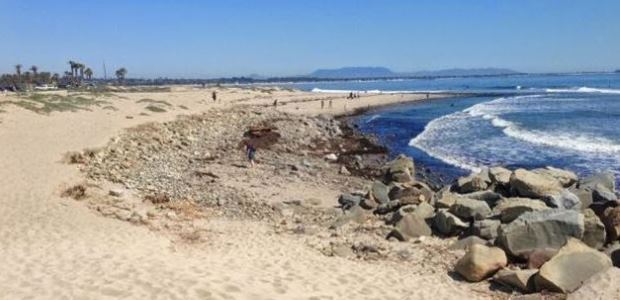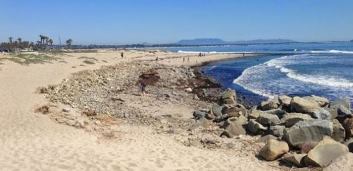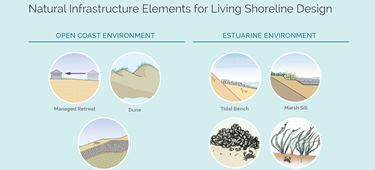
From Grey to Green: Developing the Guidelines for Natural Infrastructure
By implementing natural infrastructure through living shoreline design, we can develop solutions that provide a multitude of benefits that include performing against the rising sea levels, managing flood risk, and providing ecological benefits, all at the same time.
On Aug. 27, 2018, the State of California released its Fourth Climate Change Assessment, which will inform a multifaceted program to defend the state from the effects of climate change, including global sea-level rise. Along with rising water, climate change will also induce higher storm surges, increase risk of flooding, and accelerate an already rapid rate of coastal habitat erosion. In years past, engineers may have taken the hard, "grey" design approach of installing a concrete seawall away from shore to break the impact of oncoming waves or "hold the line" of rising tides. In fact, according to a study in 2015, "22,842 km of continental US shoreline—approximately 14% of the total US coastline—has been armored[i]" in this fashion. While this approach may have been the best solution at the time, the tide is changing.
Environmental Science Associates (ESA), in collaboration with The Nature Conservancy, Point Blue, and the National Oceanic and Atmospheric Administration’s Site Sentinel Cooperative, has developed the "Natural Shoreline Infrastructure: Technical Guidance for the California Coast," a guideline and toolset for the implementation of natural infrastructure elements as accountable, effective, and sustainable solutions for protecting our shores against sea-level rise. In addition to flood protection, natural shoreline infrastructure can offer a range of benefits, such as adding habitat value or increasing recreational access. This technical guidance document helps users evaluate the potential for natural infrastructure at a specific site, taking tide range, wave exposure, total water levels, beach width, and foreshore/backshore/planform, as well as possible infrastructure elements, into consideration. The purpose of the study is to start closing the gap of technical guidance and boost natural shoreline infrastructure as a replacement for the traditional and more widely accepted armored approach.
ESA's coastal engineering experts collaborated with Point Blue in scientifically and methodically classifying each type of infrastructure with a low-, medium-, and high-applicability rating for the pilot Blueprint web app tool in Monterey and Ventura Counties; this tool will be available in December 2018. The geospatial analysis not only indicates the suitability of the natural shoreline infrastructure type at a site, but also shows the additional amount of planform space required to increase a suitability ranking from low to high. This approach applies real-world logic with an understanding that every site is unique and there is no one-size-fits-all solution.
With coastal engineers along the West and Gulf Coasts, ESA has designed and implemented natural infrastructure projects in a variety of situations, incorporating specialized solutions. In Ventura, Calif., we provided conceptual planning and design in 1997 for the Surfers' Point Managed Shoreline Retreat Project. Over time, severe erosion of nourished sand beach had degraded public access to this popular coastal recreation area, including the collapse of a significant portion of a public bike path and parking lot. The design and engineering approach involved restoring approximately 1,800 linear feet of back beach shoreline to its natural conditions, using native materials, grading, planting, and maintenance of public access to recreation opportunities. Part of this approach involved a cobble-and-sand berm to balance restoration of natural conditions with recreational needs. The project has performed as designed, handling erosion concerns during strong El Niño storms. Today, the beach is once again the most visited in Ventura County.
(The Paul Jenkin photos below show, at top, Surfer's Point in Ventura, Calif., before the project and, below, after it. Surfer's Point has been transformed after implementing managed retreat and restoring the natural processes of the coast.)


ESA's scientists have also been working with local municipalities along the Florida coast to combat sea-level rise and flooding since 2000. In one instance, in Tampa Bay's Safety Harbor, a dilapidated seawall was identified as needing replacement. After speaking with the town about our ability to assist in securing grant funding and the long-term benefits of a softer approach, we put forward a natural infrastructure design solution. The final design includes removing the existing seawall structure and re-grading the bank to match a natural slope, protected by the addition of a pyramid of oyster bags. When construction starts in the fall of 2018, the slope will be stabilized with native vegetation. This same approach was successfully employed for the Honi Hanta Girl Scout camp in Bradenton, Fla., where the living shoreline has been functioning as planned for more than a decade and has withstood numerous storms, including Hurricane Irma (Cat 2), which went directly over this site in 2017.
There are times when a hybrid or bio-veneer approach is the best solution, such as when a seawall cannot be removed because of adjacent infrastructure conflicts. By enhancing an existing seawall with the addition of riprap specifically designed to match the soil parameters, these seawall enhancement projects can provide ecological benefits and strengthen the wall's integrity. While this approach will not mitigate effects of sea-level rise as effectively as a living shoreline, it will prolong the structure's usable lifetime. At Ulele Springs in Tampa Bay, a section of an existing seawall was removed to re-create an artesian spring-fed creek that existed a century before. The remaining seawall sections were then enhanced with mangrove planters—this was the first "living seawall" of its kind done in Florida. Now, four years later, the mangroves are reaching 7 feet tall and, together with the rock, have become a cohesive part of the shoreline, as designed.

(Graphic by Environmental Science Associates)
Living shorelines are being implemented in a number of locations nationally; however, because of regulatory obstacles, these design options are not always considered. To address this issue, in 2015 ESA co-authored a national report sponsored by Restore America’s Estuaries[ii] to assess the regulatory hindrances and identify rule changes that would encourage the implementation of green infrastructure designs. This has resulted in the recently introduced Nationwide 54 Permit exemption, specifically for living shorelines by the U.S. Army Corps of Engineers (USACE). In many states, after the adaptation of the USACE's Nationwide 54 Permit, the state regulatory agencies also provided new programmatic exemptions for the permitting of living shoreline designs to match the new federal authorization.
Although they are peppering our coasts and bay shores on a national scale, living shorelines are still an emerging science. With the publication of the "Natural Shoreline Infrastructure: Technical Guidance for the California Coast" as part of the Fourth Climate Change Assessment, coastal planners and engineers can use it as a blueprint tool to determine the best approach for their site. In Florida, Broward County requested that ESA formulate specific design plans to address their aging seawall conditions under four prevalent scenarios (deep water with and without wakes and shallow water with and without wakes) so land owners have the guidance they need to improve their shoreline conditions. By implementing natural infrastructure through living shoreline design, we can develop solutions that provide a multitude of benefits that include performing against the rising sea levels, managing flood risk, and providing ecological benefits, all at the same time.
Tiffany Cheng, PE, is a coastal engineer in Environmental Science Associates' (ESA) San Francisco office and can be reached at tcheng@esassoc.com. Thomas Ries is the director of Biological Services and Restoration for the firm’s Southeast region and can be reached at tries@esassoc.com. Bob Battalio, PE, leads ESA's Environmental Hydrology Coastal Zone Engineering & Management team and can be reached at bbattalio@esassoc.com.
[i] "Engineering away our natural defenses: an analysis of shoreline hardening in the US," Ecological Society of America, https://doi.org/10.1890/150065, R. Gittman, F. Fodrie, A. Popowich, D. Keller, J. Bruno, C. Currin, C. Peterson, M. Piehler.